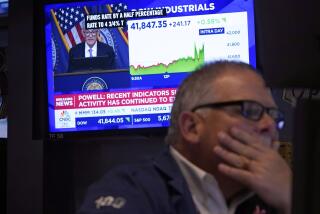U.S. Cuts Savings Bond Interest : Falls From 7.5% to 6%; Investors Rush to Buy at Old Rate
The Treasury Department slashed the minimum guaranteed interest on U.S. Savings Bonds from 7.5% to 6% today, touching off a coast-to-coast buying spree by small investors.
“We’re selling out,” said Doris Steele, a senior vice president at Flagler Federal Savings & Loan in Miami.
The Los Angeles branch of the Federal Reserve opened its lobby doors at 9:30 this morning, half an hour early, and put on three extra tellers.
“There were 35 to 40 people” waiting to get in, said Ted Schroeder, a Fed assistant vice president. About 500 customers showed up on Thursday in anticipation of the rate cut, Schroeder added, “and today is a repeat of yesterday.”
“As many as 60 people are in the lobby at any one time” to buy bonds, he said while surveying the lines at the Fed facility on West Olympic Boulevard near downtown Los Angeles.
Surge in Popularity
The popularity of Series EE bonds surged this year because rates on other government securities, bank certificates of deposit, savings accounts and money market funds slid recently to between 4% and 7%.
But the 7.5% minimum was costly to the government.
Savings bond sales averaged $621 million a month between February and April, leaped to $750 million between May and July and rocketed to $1.2 billion in August.
The new minimum--6% guaranteed even if rates fall on other securities--applies to Series EE bonds purchased after Nov. 1, and will remain in effect “until such time as market conditions may require a change,” a Treasury Department statement said.
Series EE bonds issued after Nov. 1 will also take longer to double their face value, 12 years instead of 10 years, and must be held for at least five years to qualify for the minimum guaranteed rate.
‘Drastic Rate Cut’
“It’s a drastic rate cut,” said Connie Bugbee, editor of Donoghue’s Money Fund Report in Holliston, Mass. “I think they did it because they have been setting themselves up to lose money.”
But the rate slashing had been expected for days and savers flocked to banks.
“They’re buying them by the 10s and 20s. It’s been unreal,” said Marlene Rodriguez, a clerk at a bank in Toledo, Ohio. At the First National Bank of Wiggins, Colo., a teller said, “We’ve had a lot of sales recently.”
“We seem to be running out of savings bonds very quickly,” said Jean Harris, a vice president at the Southeast Bank in Miami. “Our strongest activity has been this week.”
Stocked Up on Bonds
“I kind of prepared for it by stocking up on bonds, but I guess not well enough,” said Teresa Ho of the Rainier National Bank in Seattle, where investors bought $400,000 worth of bonds Thursday.
In 1982, when banks were paying double-digit rates on savings certificates and money funds, President Reagan signed a bill making savings bonds more attractive to investors.
The legislation instituted the guaranteed minimum rate and tied the interest to the fluctuating market rate.
Series EE bonds, also available through payroll deductions, are sold in denominations as low as $25, and are exempt from state and local income taxes. Federal tax is deferred until a bond is redeemed or reaches maturity.
More to Read
Inside the business of entertainment
The Wide Shot brings you news, analysis and insights on everything from streaming wars to production — and what it all means for the future.
You may occasionally receive promotional content from the Los Angeles Times.










